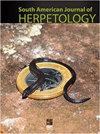哥伦比亚加勒比热带干旱森林五种无尾动物的营养关系:时空分析
IF 0.7
4区 生物学
Q4 ZOOLOGY
引用次数: 1
摘要
摘要蟾蜍科和细趾蟾蜍科的物种在哥伦比亚热带干燥森林中很常见。尽管其中一些与白蚁和蚂蚁的积极觅食和消费有关,但它们的营养生态大多不为人知。在哥伦比亚加勒比海的六个地点,在干燥的森林碎片和不同的土地利用中,对蟾蜍科(Rhinella horribilis,R.humboltti)和细趾蟾蜍亚科(Engystomops pustulosus,Pleurodema brachyops和Pseudopaludicola pusilla)的五种无尾蟾蜍的饮食进行了检查。共发现310种食品。贡献最大的是鞘翅目、膜翅目(蚁科)、等翅目和直翅目。不同物种的猎物数量和数量不同。除了表现为多面手捕食者的Pusila Pseudopaludicola外,该物种对白蚁和蚂蚁的摄入量很高。脓疱蟾蜍喜欢白蚁,短胸胸蟾蜍对蚂蚁和白蚁的消耗量很高,这两种蟾蜍都是食蚁蟾蜍。除pusilla假单胞菌外,捕食者和猎物的大小也有相关性。在分析订单级别确定的食物时,大多数物种的饮食(在空间和时间上)重叠。然而,这些目中不同猎物的丰富性允许物种共存。这些物种的饮食在其分布区的不同栖息地呈现出相似的趋势。本文章由计算机程序翻译,如有差异,请以英文原文为准。
Trophic Relationships among Five Species of Anura in the Colombian Caribbean Tropical Dry Forest: A Spatial and Temporal Approach
Abstract. Species of Bufonidae and Leptodactylidae are common in the Colombian tropical dry forest. Although some of them are associated with active foraging and consumption of termites and ants, their trophic ecology is mostly unknown. The diet of five anuran species of Bufonidae (Rhinella horribilis, R. humboldti) and the leptodactylid subfamily Leiuperinae (Engystomops pustulosus, Pleurodema brachyops, and Pseudopaludicola pusilla) was examined at six sites of the Colombian Caribbean in fragments of dry forest and different land uses. A total of 310 food items were identified. The greatest contribution was represented by Coleoptera, Hymenoptera (Formicidae), Isoptera, and Diptera. The species differed in number and volume of prey. Except for Pseudopaludicola pusilla, which behaves as a generalist predator, species had high intake of termites and ants. Engystomops pustulosus preferred termites, Pleurodema brachyops had high consumption of ants and termites, and the two bufonid species were myrmecophagous. Except for Pseudopaludicola pusilla, predator and prey size was related. Most species have overlapping diets (spatially and temporally) when analyzing food items identified at the order level. However, the richness of different prey within these orders allows the coexistence of species. The diet of these species presents similar trends in different habitats throughout their distribution area.
求助全文
通过发布文献求助,成功后即可免费获取论文全文。
去求助
来源期刊
CiteScore
1.50
自引率
0.00%
发文量
10
期刊介绍:
The South American Journal of Herpetology (SAJH) is an international journal published by the Brazilian Society of Herpetology that aims to provide an effective medium of communication for the international herpetological community. SAJH publishes peer-reviewed original contributions on all subjects related to the biology of amphibians and reptiles, including descriptive, comparative, inferential, and experimental studies and taxa from anywhere in the world, as well as theoretical studies that explore principles and methods.

 求助内容:
求助内容: 应助结果提醒方式:
应助结果提醒方式:


